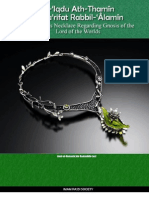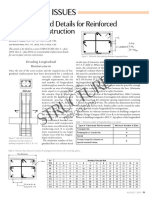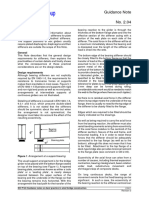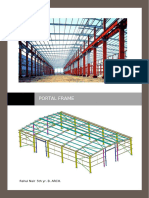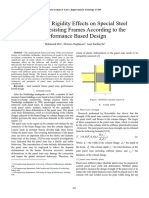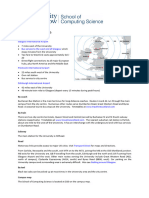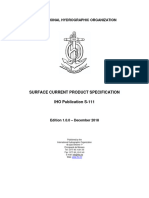Steel Moment Connections To Column Webs
Steel Moment Connections To Column Webs
Uploaded by
Vineetha KrishnanCopyright:
Available Formats
Steel Moment Connections To Column Webs
Steel Moment Connections To Column Webs
Uploaded by
Vineetha KrishnanOriginal Title
Copyright
Available Formats
Share this document
Did you find this document useful?
Is this content inappropriate?
Copyright:
Available Formats
Steel Moment Connections To Column Webs
Steel Moment Connections To Column Webs
Uploaded by
Vineetha KrishnanCopyright:
Available Formats
MOMENT CONNECTIONS
TO COLUMN WEBS
By M. Thomas Ferrell
This article will present
details that will accommodate
mill and shop tolerances of struc-
tural members, as well as provid-
ing for material ductility. It will
also present limit state strength
considerations for both moment
connections with field welded
beam flanges and field bolted
flange plates.
MOMENT CONNECTION
WITH FIELD WELDED
BEAM FLANGES
(FIGURE 1)
1. The connection plates must be
the same grade of material as
the weak axis moment beam.
2. The connection plate has been
extended ¾” minimum beyond
the column flange to provide bet-
ter toughness and ductility.
AISC’s Manual of Steel
Construction (LRFD) Volume
II—Connections, pages 10-60
through 10-65, has summarized
results of nine simulated weak
axis FR moment connection tests
performed by Driscoll, et. al., to
aid in selection of details to
ensure ductility.
3. The top connection plate
thickness is equal to tf plus ¼”.
This additional thickness is nec-
essary to accommodate toler-
ances for fabrication and beam
flange tilt. Note that the bottom 4. The bottom connection plate ble overrun/under-run in the
of this connection plate is thickness is equal to tf plus 3/8”. beam depth. Note that the cen-
aligned with the bottom of the This is necessary to accommo- terline of this connection plate is
beam top flange. date tolerances for fabrication aligned with the centerline of the
and beam flange tilt plus possi- bottom flange of the beam.
Modern Steel Construction / March 1998
nection plates must be designed
for shear stresses due to the
eccentricity from the neutral
axis of the bolt group to the edge
of the column flange. If a column
web doubler is required due to a
strong axis moment beam, then
the additional stresses from the
shear plate must be considered
in determining the thickness of
the web doubler plate.
MOMENT CONNECTIONS
WITH BEAM FLANGE
PLATES (FIGURE 2)
1. It is not necessary for the
flange plates to be the same
grade of material of the weak
axis moment beam.
2. Oversized holes should be
used in the flange plates to allow
for mill tolerances in the column
beam. These connections with
oversized holes must be designed
as slip critical. If tension control
bolts are used, if possible use a
bolt gage that will allow bolts at
the bottom flange to be tightened
from inside of the beam flange.
In many cases, this is not possi-
ble due to beam flange widths
and beam depths.
3. Shims must be provided at the
top or bottom flanges to accom-
modate fabrication and mill tol-
erances for flange tilt plus possi-
ble overrun/under-run in beam
depths. Fabricators normally
5. The welds for connection 6. Bolts for the shear plate to prefer the shims to be at the bot-
plates to the column flanges beam web are normally located tom flange due to restrictions on
must be designed for shear outside of the column flanges. programming of shop equipment.
forces. These welds may also be This practice simplifies beam If shims are provided at the top
subjected to tensile/compression erection and allows access to flange, the detail can be provided
and shear forces when these tighten the bolts with use of an to serve as a deck support (figure
plates serve as stiffener plates impact wrench. Short slots 3).
for a strong axis moment beam. should be used in the plate and
Use fillet welds where possible. standard holes in the beam web. 4. The flange plates must be
It is good practice to deduct Flange welds should be complet- designed for tension yielding,
twice the weld size from the ed before the bolts are tightened. tension rupture, and compres-
length of plate available for The short slots will “hold” top of sion strength.
welding so that the welds do not beam elevation and allow for 5. The flange bolts must be
terminate at the edges of the weld shrinkage to occur at the designed for shear strength.
plate or column flange. If calcu- flange welds. The bolts are
lated stresses are transferred designed for shear forces only 6. The beam design flexural
through the welds at the column (no eccentricity). The welds for strength with regard to net sec-
web, then back-up stiffener the shear plate-to-column web tion must be determined to
plates must be provided. are designed for shear only. The assure that the net beam section
welds for the shear plate-to-con- is adequate without reinforcing.
Modern Steel Construction / March 1998
7. The welds for the flange plates
to the column flanges/webs are
designed using the same criteria
used for the connection plates for
the field welded flange moment
beams in figure 1.
8. The web shear plate design is
the same as for the field welded
flange moment beams.
This article is adapted from a
paper by M. Thomas Ferrell,
P.E., for the 1998 National Steel
Construction Conference. Ferrell
is President of Ferrell
Engineering, Inc., a specialty
structural engineering firm locat-
ed in Birmingham, AL.
You might also like
- The Precious NecklaceDocument22 pagesThe Precious Necklaceimamrassisociety100% (1)
- 17.HSAJB Pathology Services Handbook 4th Edition 2019Document131 pages17.HSAJB Pathology Services Handbook 4th Edition 2019siti nur aishah jalilNo ratings yet
- Anchoring Into Housekeeping Pads: ConcreteDocument2 pagesAnchoring Into Housekeeping Pads: ConcreteFredie UnabiaNo ratings yet
- History of The OttoDocument9 pagesHistory of The OttoAshish AgarwalNo ratings yet
- Moment Connection TipsDocument7 pagesMoment Connection TipsManoj JaiswalNo ratings yet
- Moment Connections To Column WebsDocument3 pagesMoment Connections To Column WebsAmro Ahmad AliNo ratings yet
- 3Document6 pages3k2org.seoNo ratings yet
- Simpson ConnectionDocument3 pagesSimpson ConnectionIac Cyp Capobianco IngenieroNo ratings yet
- Recommended Details For Reinforced Concrete ConstructionDocument3 pagesRecommended Details For Reinforced Concrete ConstructionYol AtienzaNo ratings yet
- Column Detailing and Design RecommendationsDocument3 pagesColumn Detailing and Design RecommendationsJohn STCNo ratings yet
- Compaction of Concrete Using Immersion and Surface Vibrators PDFDocument12 pagesCompaction of Concrete Using Immersion and Surface Vibrators PDFmehdi_hoseinee0% (1)
- Bolted Beam Column ConnectionsDocument16 pagesBolted Beam Column Connectionssgopalkn7559100% (1)
- Code Commentary: R21.5 - Flexural Members of Special Moment Frames 21.5 - Flexural Members of Special Moment FramesDocument1 pageCode Commentary: R21.5 - Flexural Members of Special Moment Frames 21.5 - Flexural Members of Special Moment Framesminhthanha6No ratings yet
- DSS PDF 2Document1 pageDSS PDF 2Antharya N shettyNo ratings yet
- AD 266 - Shear Connection in Composite BeamsDocument2 pagesAD 266 - Shear Connection in Composite Beamssymon ellimacNo ratings yet
- The Design of Hybrid Fabricated Girders Part 1 PDFDocument3 pagesThe Design of Hybrid Fabricated Girders Part 1 PDFLingka100% (1)
- (EC3Steel) Guidance Note On Bearing StiffenersDocument4 pages(EC3Steel) Guidance Note On Bearing Stiffenershaijiang wangNo ratings yet
- Panel Zone Rigidity Effects On Special Steel MomenDocument8 pagesPanel Zone Rigidity Effects On Special Steel Momenk9anh.1999No ratings yet
- Structural Corrosion Issues in Aggregate Processing PlantsDocument15 pagesStructural Corrosion Issues in Aggregate Processing PlantsLarry DeemNo ratings yet
- Reinforcing Steel in Slabs On Grade - tcm45-346883Document3 pagesReinforcing Steel in Slabs On Grade - tcm45-346883gurpreets_807665No ratings yet
- CE Board Nov 2020 - RCD - Set 6 ColoredDocument3 pagesCE Board Nov 2020 - RCD - Set 6 ColoredDale MalazzabNo ratings yet
- Signs Sn13Document2 pagesSigns Sn13Rao MadepalliNo ratings yet
- Layering Reinforcing Bars: @seismicisolationDocument26 pagesLayering Reinforcing Bars: @seismicisolationali tahaNo ratings yet
- Geonor RST Subsurface Settlement Heave PointsDocument1 pageGeonor RST Subsurface Settlement Heave PointsNguyen Quoc KhanhNo ratings yet
- Predicting The Effective Flange Width of A CLT Slab in Timber Composite BeamsDocument18 pagesPredicting The Effective Flange Width of A CLT Slab in Timber Composite BeamsBambus Promete100% (1)
- design of ductilityDocument16 pagesdesign of ductilityramankumar83072No ratings yet
- Design Guide 7 Errata PDFDocument10 pagesDesign Guide 7 Errata PDFelidstone@hotmail.comNo ratings yet
- Joints in Steel Construction - Simple Connections - Part 10 PDFDocument9 pagesJoints in Steel Construction - Simple Connections - Part 10 PDFkakem61No ratings yet
- Structural Corrosion Issues in Aggregate Processing PlantsDocument16 pagesStructural Corrosion Issues in Aggregate Processing PlantsLarry DeemNo ratings yet
- GN Guideline 108Document2 pagesGN Guideline 108sparta_avatarNo ratings yet
- AASTHO Horizontally Curved Steel Girder Highway Bridges 2003 - Part2 PDFDocument28 pagesAASTHO Horizontally Curved Steel Girder Highway Bridges 2003 - Part2 PDFMehedi HasanNo ratings yet
- 2006 Beam Column Joint ICJ PDFDocument9 pages2006 Beam Column Joint ICJ PDFSanjeev MishraNo ratings yet
- 2006 Beam Column Joint ICJDocument9 pages2006 Beam Column Joint ICJvishalgoreNo ratings yet
- Portal Frame (2)Document9 pagesPortal Frame (2)JoeyBaxterNo ratings yet
- Mason Industries, Inc.: ND MountsDocument2 pagesMason Industries, Inc.: ND MountsErwin MaldoNo ratings yet
- Heating Pipes in Composite Floors - Effects On Slab Beam DesignDocument2 pagesHeating Pipes in Composite Floors - Effects On Slab Beam DesignJianhua WuNo ratings yet
- Design Guidelines Highpressure DiecastingDocument2 pagesDesign Guidelines Highpressure DiecastingHidayatNo ratings yet
- Castellated GirderDocument14 pagesCastellated Girderpriyesh jainNo ratings yet
- Design of Suspended Flat SlabDocument1 pageDesign of Suspended Flat SlabKim Limuel Tabago GomezNo ratings yet
- Concrete Construction Article PDF - Blind-Side and One-Sided FormingDocument3 pagesConcrete Construction Article PDF - Blind-Side and One-Sided FormingValentínNo ratings yet
- Soporte AntivibratorioDocument2 pagesSoporte AntivibratorioGerman GinesNo ratings yet
- Wide Beam Stirrup PDFDocument3 pagesWide Beam Stirrup PDFPatipol Gunhomepoo100% (1)
- FLAT SLAB 0000-ModelDocument1 pageFLAT SLAB 0000-Modelsyeda nabila fatimaNo ratings yet
- Regan 2004Document8 pagesRegan 2004Ghazi Bahroz JumaaNo ratings yet
- Laterally Unrestrained BeamsDocument12 pagesLaterally Unrestrained BeamsVikram50% (2)
- 003 FCSDocument1 page003 FCSDhana SekarNo ratings yet
- Zona PanelDocument7 pagesZona PanelrobertNo ratings yet
- AISC Design Guide 13 Errata - Stiffening of Wide-Flange Column at Moment Connections PDFDocument2 pagesAISC Design Guide 13 Errata - Stiffening of Wide-Flange Column at Moment Connections PDFFernando Gutiérrez UrzúaNo ratings yet
- Types of CracksDocument14 pagesTypes of Cracksasl halNo ratings yet
- Brace ConfigDocument1 pageBrace ConfigmrmerajNo ratings yet
- A Beam Is A BeamDocument2 pagesA Beam Is A BeampicottNo ratings yet
- 2-Flange Tunnel Liner Plate Design Guide: 2nd EditionDocument20 pages2-Flange Tunnel Liner Plate Design Guide: 2nd Editionjuancaf773557No ratings yet
- Some Mooted Questions in Reinforced Concrete Design American Society of Civil Engineers, Transactions, Paper No. 1169, Volume LXX, Dec. 1910From EverandSome Mooted Questions in Reinforced Concrete Design American Society of Civil Engineers, Transactions, Paper No. 1169, Volume LXX, Dec. 1910No ratings yet
- Rock Blasting: A Practical Treatise on the Means Employed in Blasting Rocks for Industrial PurposesFrom EverandRock Blasting: A Practical Treatise on the Means Employed in Blasting Rocks for Industrial PurposesNo ratings yet
- Weak Plate Strong Bolt Model Eccentrically Loaded BoltDocument8 pagesWeak Plate Strong Bolt Model Eccentrically Loaded BoltVineetha KrishnanNo ratings yet
- Snap 039Document1 pageSnap 039Vineetha KrishnanNo ratings yet
- 2004v01 Grade 65Document1 page2004v01 Grade 65Vineetha KrishnanNo ratings yet
- Stud Thru PaintDocument1 pageStud Thru PaintVineetha KrishnanNo ratings yet
- Pages From Genie Floor Loadings ScissorsDocument1 pagePages From Genie Floor Loadings ScissorsVineetha KrishnanNo ratings yet
- Jopist Web OpeningsDocument1 pageJopist Web OpeningsVineetha KrishnanNo ratings yet
- Plastic Analysis Notes PDFDocument14 pagesPlastic Analysis Notes PDFVineetha KrishnanNo ratings yet
- M. Tech. EXAMINATION, May 2019: No. of Printed Pages: 05 Roll No. ......................Document3 pagesM. Tech. EXAMINATION, May 2019: No. of Printed Pages: 05 Roll No. ......................Vineetha KrishnanNo ratings yet
- Connection Designfor Industrial Structures Problemsand SolutionsDocument14 pagesConnection Designfor Industrial Structures Problemsand SolutionsVineetha KrishnanNo ratings yet
- Embedded Column Bases No DissDocument16 pagesEmbedded Column Bases No DissVineetha KrishnanNo ratings yet
- Diaphragm Continuity Over Gable Roof Ridge 2Document1 pageDiaphragm Continuity Over Gable Roof Ridge 2Vineetha KrishnanNo ratings yet
- Chair Baseplate Weak Axis BendingDocument17 pagesChair Baseplate Weak Axis BendingVineetha KrishnanNo ratings yet
- Theory of Structures by S Ramamrutham PDFDocument14 pagesTheory of Structures by S Ramamrutham PDFVineetha Krishnan0% (1)
- Advanced Concrete Technology-Notes PDFDocument36 pagesAdvanced Concrete Technology-Notes PDFVineetha KrishnanNo ratings yet
- Bolted Truss Column Connections - xlsx-29!14!2020Document34 pagesBolted Truss Column Connections - xlsx-29!14!2020Vineetha KrishnanNo ratings yet
- MT Ce Se 2018Document58 pagesMT Ce Se 2018Vineetha KrishnanNo ratings yet
- Return To TOC: Dowty Propellers Standard Practices ManualDocument2 pagesReturn To TOC: Dowty Propellers Standard Practices ManualNicolás PiratovaNo ratings yet
- Sustainable Development in IndiaDocument14 pagesSustainable Development in Indiafomi89No ratings yet
- Huawei AirEngine 6760R-51 & AirEngine 6760R-51E Access Points Datasheet PDFDocument14 pagesHuawei AirEngine 6760R-51 & AirEngine 6760R-51E Access Points Datasheet PDFkhgNo ratings yet
- Genbio2 q2 Mod1.1 Reproduction-And-DevelopmentDocument9 pagesGenbio2 q2 Mod1.1 Reproduction-And-DevelopmentHazel AbitriaNo ratings yet
- ProjectDocument1 pageProjectDevil KingNo ratings yet
- DiphtheriaDocument3 pagesDiphtheriaAjay Pal NattNo ratings yet
- CO2 Molecular Gas Laser Principle, Construction, Working, Characteristics, Advantages, Disadvantages and ApplicationsDocument6 pagesCO2 Molecular Gas Laser Principle, Construction, Working, Characteristics, Advantages, Disadvantages and ApplicationsSunil DahaleNo ratings yet
- HKPO09 Sol A PDFDocument4 pagesHKPO09 Sol A PDFlagostinhaNo ratings yet
- Centralizers & StopCollarsDocument19 pagesCentralizers & StopCollarsSaurabh Parihar100% (2)
- Educ0005 - Science FPDDocument15 pagesEduc0005 - Science FPDapi-409729360No ratings yet
- DS-PK1-LRT-HWEHWB - Datasheet - TECLADO LCD ALARMADocument3 pagesDS-PK1-LRT-HWEHWB - Datasheet - TECLADO LCD ALARMALuis EduardoNo ratings yet
- Btvn Unit 9 Bài Tập VocabDocument7 pagesBtvn Unit 9 Bài Tập Vocab13. Đỗ Thuỳ DươngNo ratings yet
- Introduction To Town Planning: Ar. Raghuteja Vemana School of ArchitectureDocument22 pagesIntroduction To Town Planning: Ar. Raghuteja Vemana School of ArchitecturecoolbuttNo ratings yet
- Cusinato Paper ENGDocument6 pagesCusinato Paper ENGcassioNo ratings yet
- Train Map To Uni. of GlasgowDocument2 pagesTrain Map To Uni. of GlasgowkellyNo ratings yet
- PortaPump Service ManualDocument5 pagesPortaPump Service ManualSarah PerezNo ratings yet
- Tosca Illustrated Clean Business Conference PresentationDocument10 pagesTosca Illustrated Clean Business Conference PresentationWisnu DewaNo ratings yet
- Health Related VocabularyDocument2 pagesHealth Related Vocabularyjunior perezNo ratings yet
- Grey's Anatomy TV Series, Season 1 - Teacher Sheila FariasDocument28 pagesGrey's Anatomy TV Series, Season 1 - Teacher Sheila FariasEmilly RafaelaNo ratings yet
- Kindergarten Lesson Plan Week 31Document11 pagesKindergarten Lesson Plan Week 31Zenith Joy JuanNo ratings yet
- Section I Notice of Development of Proposed Rules and Negotiated RulemakingDocument24 pagesSection I Notice of Development of Proposed Rules and Negotiated RulemakingpaulNo ratings yet
- S-111 Ed 1.0.0 Surface Current Product Specification - FinalDocument108 pagesS-111 Ed 1.0.0 Surface Current Product Specification - FinalTiền Phạm TiếnNo ratings yet
- 3D and Holographic ImagingDocument7 pages3D and Holographic ImagingViviNo ratings yet
- Soc124 Thomas EdisonDocument8 pagesSoc124 Thomas EdisonKaren VillaruelNo ratings yet
- Filipino Culture Values and Practices MCNDocument20 pagesFilipino Culture Values and Practices MCNKimberly Marie Bayang100% (1)
- You Can Know The Latest News About The Oilfield Hoses Area and Jingbo Petroleum Machinery Co.,Ltd.Document1 pageYou Can Know The Latest News About The Oilfield Hoses Area and Jingbo Petroleum Machinery Co.,Ltd.Projetos MecanicosNo ratings yet
- Ethics Module Lesson3Document6 pagesEthics Module Lesson3Cristine Mae PreguntaNo ratings yet
